Truck classification
Truck classifications are typically based upon the maximum loaded weight of the truck (typically using the gross vehicle weight rating (GVWR) and sometimes also the gross trailer weight rating (GTWR), and can vary among jurisdictions.
United States
In the United States, commercial truck classification is determined based on the vehicle's gross vehicle weight rating (GVWR). The classes range from 1–8.[1][2] Trucks are also classified more broadly by the Department of Transportation's Federal Highway Administration (FHWA), which groups classes 1–3 as light duty, 4–6 as medium duty, and 7–8 as heavy duty and a Commercial drivers license is generally required[1][3][4][5] The United States Environmental Protection Agency has a separate system of emissions classifications for trucks.[1][6] The United States Census Bureau also assigned classifications in its now-discontinued Vehicle Inventory and Use Survey (VIUS) (formerly Truck Inventory and Use Survey (TIUS)).[7]
Table of US GVWR classifications
| US truck class | Duty classification | Weight limit [1][8] | Examples |
|---|---|---|---|
| Class 1 | Light truck | 0–6,000 pounds (0–2,722 kg) | Dodge Dakota, Chevrolet Colorado/GMC Canyon, Toyota Tacoma, Nissan Frontier, Ford Ranger[9] |
| Class 2 | Light truck | 6,001–10,000 pounds (2,722–4,536 kg) | Ram 1500, Chevrolet Silverado 1500, Ford F-150 |
| Class 3 | Light truck | 10,001–14,000 pounds (4,536–6,350 kg) | Ram 3500, GMC Sierra 3500, Ford E-350, Ford F-350, Hummer H1 |
| Class 4 | Medium truck | 14,001–16,000 pounds (6,351–7,257 kg) | Ram 4500, GMC 4500, Ford E-450, Ford F-450 [9], HINO 155 COE[10] |
| Class 5 | Medium truck | 16,001–19,500 pounds (7,258–8,845 kg) | Ram 5500, GMC 5500, Ford F-550, Peterbilt 325, International TerraStar [11], HINO 195 COE[12] |
| Class 6 | Medium truck | 19,501–26,000 pounds (8,846–11,793 kg) | Chevrolet Kodiak C6500, Ford F-650, Peterbilt 330, International Durastar [13], HINO 268 & 268A[14] |
| Class 7 | Heavy truck | 26,001–33,000 pounds (11,794–14,969 kg) | Autocar ACMD, GMC C7500, Peterbilt 220 & 337, Ford F-750 [15], HINO 338[16] |
| Class 8 | Heavy truck | 33,001 pounds (14,969 kg)+ | Autocar ACX, International WorkStar, Kenworth T600, Kenworth T660, Kenworth T680, Peterbilt 579, Peterbilt 389[17] - Semi-trailer trucks fall into this category |
| Class 9 | Super-heavy / special duty truck | 33,001 pounds (14,969 kg)+ | Usually class 8 truck with special duty characteristics, e.g. - Autocar ACX 12x6, International WorkStar, Western Star 6900 (6900XD or 6900TS).[18][19][20][21][22] |
Notes on weight classes
Class 2
Class 2 is subdivided into Class 2a (½-ton) and Class 2b (¾-ton), with class 2a being 6,001–8,500 pounds (2,722–3,856 kg), and class 2b being 8,501–10,000 pounds (3,856–4,536 kg). Examples of vehicles in Class 2b include the Ram 2500, Chevrolet Silverado 2500, and the Ford F-250. SUVs in Class 2b include the Ford Excursion and the Chevrolet Suburban 2500. Class 2a is commonly referred to as a light duty truck, with class 2b being the lowest heavy-duty class, also called the light heavy-duty class.[9][23][24]
Medium duty ton rating
When light-duty trucks were first produced in the United States, they were rated by their payload capacity in tons (e.g., ½-, ¾- and 1-ton). Over time, payload capacities for most domestic pickup trucks have increased while the ton titles have stayed the same. The now-imprecise ton rating is presently used to compare standard sizes, rather than actual capacities.
This has led to categorizing trucks similarly, even if their payload is different. Therefore, the Toyota Tacoma, Dodge Dakota, Ford Ranger, Honda Ridgeline, Chevrolet S-10, GMC S-15 and Nissan Frontier are called quarter-tons (¼-ton). The Ford F-150, Chevrolet C10/K10, Chevrolet/GMC 1500, Dodge 1500, Toyota Tundra, and Nissan Titan are half-tons (½-ton). The Ford F-250, Chevrolet C20/K20, Chevrolet/GMC 2500, and Dodge 2500 are three-quarter-tons (¾-ton). Chevrolet/GMC's ¾-ton suspension systems were further divided into light and heavy-duty, differentiated by 5-lug and 6 or 8-lug wheel hubs depending on year, respectively. The Ford F-350, Chevrolet C30/K30, Chevrolet/GMC 3500, and Dodge 3500 are one tons (1-ton).
Similar schemes exist for vans and SUVs (e.g. a 1-ton Dodge Van or a ½-ton GMC Suburban), medium duty trucks (e.g. the Ford 1½-ton F-450) and some military vehicles, like the ubiquitous deuce-and-a-half.
Class 7
Vehicles in Class 7 and above require a Class-B commercial driver's license (CDL) to operate in the United States.
Class 8
The Class 8 truck gross vehicle weight rating (GVWR) is a vehicle with a GVWR exceeding 33000 lb (14969 kg).[1][25] These include tractor trailer tractors as well as single-unit dump trucks of a GVWR over 33,000 lb; such trucks typically have 3 or more axles. The typical 5-axle tractor-trailer combination, also called a "semi" or "18-wheeler", is a Class 8 vehicle. Standard trailers vary in length from 8' containers to 57' van trailers, with the most common length being the 53' trailer. Specialized trailers for oversized loads can be considerably longer. Commercial operation of a Class 8 vehicle in the United States requires either a Class-B CDL for non-combination vehicles, or a Class-A CDL for combination vehicles (tractor-trailers).
The practical gross vehicle weight limit in the U.S. for Class 8 trucks is determined by per-axle weight limits set by the Federal Bridge Gross Weight Formula on interstate highways. Longer 18-wheelers can weigh up to 80,000 lbs. In most states, exceptions to these limits can be made for an Oversize load but they require special permits and handling on a designated route.
Class 9/Super heavy duty
Usually classifies a heavy, special duty Class 8 truck. For example the Western Star 6900 is designed for off-highway vocations including logging, mining, and other similar applications.
Canada
Vehicle classifications vary among provinces in Canada, due to "differences in size and weight regulations, economic activity, physical environment, and other issues".[26]:3 While several provinces use their own classification schemes for traffic monitoring, Manitoba, Ontario, Prince Edward Island and Saskatchewan have adopted the 13-class system from the United States' Federal Highway Administration—sometimes with modifications, or in Ontario's case, for limited purposes.[26]:3–4 British Columbia and Ontario also distinguish between short- and long-combination trucks.[26]:3–4 In accident reporting, eight jurisdictions subdivide trucks by GVWR into light and heavy classes at approximately 4500 kg 9921 lb.[26]:6
European Union
In the European scheme the licenses are (among others) B for cars, C for trucks (lorries), D for buses, and are limited by the GVWR.
Divides into two types:
- appending a number to the class denotes the "light" versions of said class.
- appending the letter E allows for larger trailers (GTWR).
- Class B permits the use of vehicles with GVWRs of not more than 3500 kg and a trailer with GTWRs not exceeding 750 kg, or a trailer above said limit, if the gross weight of car and trailer combined does not exceed 3500 kg (or 4250 kg after a theoretical and practical course of 7 hours). Such vehicles are also commonly known as light commercial vehicles (LCVs), and include the Ford Transit, Mercedes-Benz Sprinter and Fiat Ducato.
- Class BE allows for trailers up to 3500 kg GTWR while driving a class B vehicle.
- Class C1 raises the GVWR limit to 7500 kg and a trailer of GTWR not exceeding 750 kg.
- Class C removes the GVWR limit, but the GTWR limit for the trailer of 750 kg stays.
- Class C1E allows for a class B or C1 vehicle and a trailer of more than 750 kg GTWR, if the combined gross weight does not exceed 12000 kg.
- Class CE removes the trailers GTWR limit while driving a Class C vehicle.
List of truck types
- Truck (Lorry) See List of truck types
Gallery
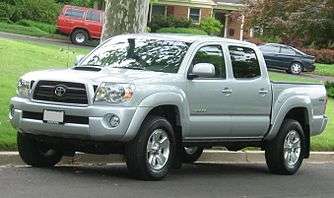 Class 1 Light duty Toyota Tacoma
Class 1 Light duty Toyota Tacoma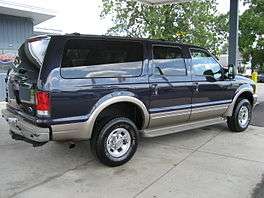 Class 2 2001 Ford Excursion 4×4 (GVWR: 8,600 pounds (3.9 t)
Class 2 2001 Ford Excursion 4×4 (GVWR: 8,600 pounds (3.9 t)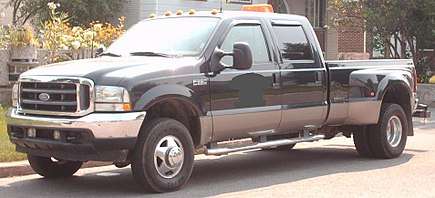 Class 3 Ford F-350
Class 3 Ford F-350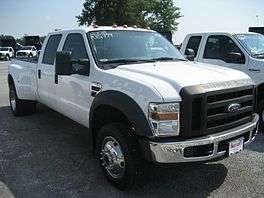 Class 4 2008 Ford F-450 4×4 pick-up truck (GVWR: 14,500 pounds (6.6 t))
Class 4 2008 Ford F-450 4×4 pick-up truck (GVWR: 14,500 pounds (6.6 t)) Class 5 2005 Chevy Kodiak 4×4 (GVWR: 17,500 pounds (7.9 t))
Class 5 2005 Chevy Kodiak 4×4 (GVWR: 17,500 pounds (7.9 t))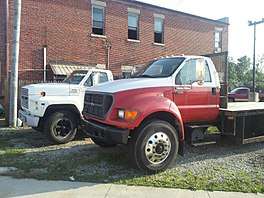 Class 6 2002 Ford F-650 in front (GVWR: 26000 lb), 1989 Ford F-600 in back (GVWR: 20,200 pounds (9.2 t)
Class 6 2002 Ford F-650 in front (GVWR: 26000 lb), 1989 Ford F-600 in back (GVWR: 20,200 pounds (9.2 t)- Class 7 Peterbilt 330 dump truck.

.jpg) Class 9 Western Star 6900XD tractor.
Class 9 Western Star 6900XD tractor.
See also
- Car classification
- Corporate Average Fuel Economy (CAFE)
- Commercial vehicle
- Curb weight
- Driver's license
- Gross weight:
- Gross axle weight rating (GAWR)
- Gross combined weight rating (GCWR)
- Gross trailer weight rating (GTWR)
- Gross vehicle weight rating (GVWR)
- Large goods vehicle
- List of truck types
- Tow hitch
- Trailer
- Vehicle category
References
- 1 2 3 4 5 Vehicle Weight Classes & Categories from the United States Department of Energy
- ↑ NTEA.com – Gross Vehicle Weight Rating (GAWR) by Class (archived)
- ↑ TMIP|Clearinghouse|Accounting for Commercial Vehicles in Urban Transportation Models Archived November 1, 2014, at the Wayback Machine.
- ↑ FHWA Vehicle Types from the United States Department of Transportation
- ↑ Truck Classification, Changingears.com, 2009-03-28, retrieved 2012-04-09
- ↑ Vehicle Weight Classifications from the United States Environmental Protection Agency
- ↑ "Vehicle Inventory and Use Survey – Discontinued". Census.gov. 2015-06-30. Retrieved 2015-08-17.
- ↑ "Class 3-4-5 Truck Model Roundup". Nextexitlogistics.com. 2014-10-22. Retrieved 2015-08-17.
- 1 2 3 "Appendix: Truck Types and Classes" (PDF). Archived from the original (PDF) on 22 July 2011. Retrieved 12 March 2018. (archived)
- ↑ RUSH TRUCK CENTER HOUSTON, Certifed HINO dealer
- ↑ Save to MyGarage (2005-02-10), 2005 Chicago Auto Show, Autobytel.com, retrieved 2012-04-09
- ↑ RUSH TRUCK CENTER HOUSTON, Certified HINO dealer
- ↑ GMC TopKick 4500
- ↑ RUSH TRUCK CENTER HOUSTON Cert. HINO Dealer
- ↑ Rik Hinton, Idaho Transportation Department (2011-12-22), Idaho Commercial Driver's License Program, Itd.idaho.gov, retrieved 2012-04-09
- ↑ RUSH TRUCK CENTER HOUSTON-Certified HINO Dealer
- ↑ http://www.peterbilt.com/products/on-highway/389/
- ↑ "Typical 6900 XD Specifications". San Diego Freightliner. Retrieved 2017-03-20.
- ↑ "Typical 6900 XD Specifications". Western Star of Las Vegas. Retrieved 2017-03-20.
- ↑ "Typical 6900 XD Specifications". Western Star of Southern California. Retrieved 2017-03-20.
- ↑ "Freightliner dealership in North Las Vegas, NV". Las Vegas Freightliner. Retrieved 2017-03-20.
- ↑ "6900". Western Star Trucks. Retrieved 2017-03-20.
- ↑ "2005 Dodge Dakota Specifications, Fuel Economy & Overview". Truck Trend. 2007-02-26. Retrieved 2012-04-09.
- ↑ http://www.epa.gov/otaq/climate/regulations/420b10039.pdf
- ↑ "International Class 7 Crew Cab Pickup". Truck Trend. 2007-02-26. Retrieved 2012-04-09.
- 1 2 3 4 Clayton, Alan; Montufar, Jeannette; Middleton, Dan; McCauley, Bill (August 27–31, 2000), "Feasibility of a New Vehicle Classification System for Canada" (PDF), North American Travel Monitoring Exhibition and Conference (NATMEC) 2000, archived from the original (PDF) on November 1, 2004, retrieved August 9, 2013,
Furthermore, the fleet characteristics vary significantly from jurisdiction to jurisdiction across the country because of differences in size and weight regulations, economic activity, physical environment, and other issues. This has led to a wide variety of vehicle classification systems used by highway agencies and municipal authorities in their traffic monitoring programs.